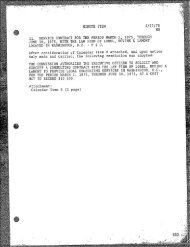Mooring Loads Due to Parallel Passing Ships - State Lands ...
Mooring Loads Due to Parallel Passing Ships - State Lands ...
Mooring Loads Due to Parallel Passing Ships - State Lands ...
You also want an ePaper? Increase the reach of your titles
YUMPU automatically turns print PDFs into web optimized ePapers that Google loves.
Modification of PASS-MOOR<br />
In order <strong>to</strong> improve the predictions from PASS-MOOR, the empirical correction<br />
fac<strong>to</strong>rs of Seelig (2001) were re-derived using the data obtained in the present study.<br />
The following results were obtained:<br />
Cx - empirical<br />
30.0<br />
25.0<br />
20.0<br />
15.0<br />
10.0<br />
5.0<br />
0.0<br />
C = 1 + 170 . e e<br />
X<br />
C = 1 + 052 . e e<br />
Y<br />
C = 1 + 048 . e e<br />
M<br />
2<br />
( 2.94( Dd / )) ( −0. 08(( GB / ) −3)<br />
)<br />
2<br />
( 4.33( Dd / )) ( −0. 08(( GB / ) −2)<br />
)<br />
2<br />
( 387 . ( Dd / )) ( −008 . (( GB / ) −2)<br />
)<br />
These are shown graphically in Figure 22. As noted in Equation (4), the experimental<br />
results for Fx- and M- were slightly higher than the corresponding positive values, so the<br />
negative peaks of these parameters and Fy+ were used <strong>to</strong> develop equation (10).<br />
These expressions have the same general form as those by Seelig in equation<br />
(9). Several differences are noted however. First, the new correction for surge force is<br />
a non-linear function of the draft-<strong>to</strong>-depth ratio. Seelig had more limited data and<br />
adopted a linear relationship as there was insufficient data <strong>to</strong> adopt any other<br />
functional form. The corrections for sway force and yaw moment retain the strong nonlinear<br />
dependence on (D/d). Second, because PASS-MOOR generally under-predicts<br />
the surge and sway force, the new corrections are larger in order <strong>to</strong> eliminate this bias.<br />
Third, while Seelig found the same correction for sway force and yaw moment, the new<br />
data suggests less correction is needed for the yaw moment than for sway force.<br />
Predictions carried out using PASS-MOOR with the revised coefficients are<br />
shown in<br />
Figure 23.<br />
0.0 2.0 4.0 6.0 8.0 10.0<br />
G/B<br />
D/d=0.90<br />
D/d=0.82<br />
D/d=0.76<br />
D/d=0.44<br />
D/d=0.26<br />
Figure 22a. Surge force correction fac<strong>to</strong>r for PASS-MOOR from equation (10)<br />
NFESC TR-6056-OCN<br />
32<br />
(10)

















